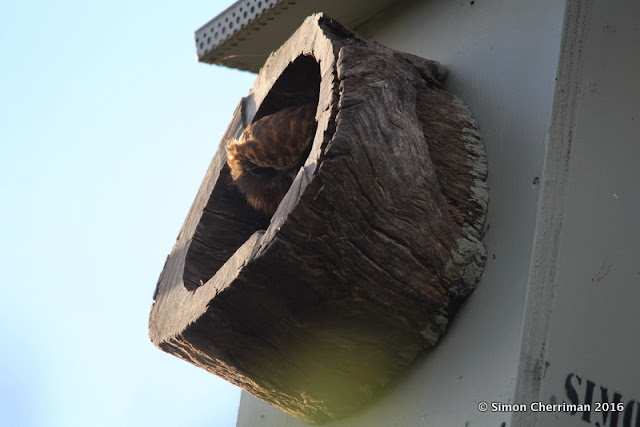I felt quite nervous ascending my climbing rope 20 metres into the canopy of this glorious Marri tree to reach the huge Wailitj / Wedge-tailed Eagle (Aquila audax) eyrie today. It was the first time I'd climbed this particular nest, and the first time I was going to attempt to catch a chick belonging to this particular pair. It was also the first time I would be fitting a juvenile wedgie from the south-west of WA with a satellite tag, so a big part of the nervous feeling was related to excitement! The rope swayed as I neared the nest and clipped my safety line around a large branch. I wiped my brow. I could just see the top of the eaglet's head.
The nest seemed large from the ground, but its sheer size really became apparent as I stood up and peered across to examine its contents. The eaglet was a male, about 10 weeks old, and almost fully feathered with beautiful rich-brown plumage. It stood firmly, lifted its wings, and in reaction to my presence, shuffled over to the opposite side of the nest. Jill Shepherd (my PhD supervisor) and Bill Brown (an eagle scientist from Tasmania who has been helping me ring/band and satellite-tag juvenile Wedge-tails this month) kept a watchful eye on the bird from one side of the nest as I adjusted my climbing ropes, while Stuart Rae (a Scottish pal currently visiting from Canberra and also helping with eagle ringing/banding and tagging) watched the chick from the other side of the nest. Even with my go-go-gadget arms, I was unable to reach the eaglet from a standing position, so I climbed onto the eyrie and quickly grabbed its legs in a secure grip, then tucked the wings under my arms, to ensure the bird could not flap around and injure itself (or me!).
Once securely inside a handling bag, the juvenile wedgie was safely lowered to the ground. Bill's expertise in handling eagles was a wonderful help, and he held the bird firmly but gently while we took measurements and fitted the metal- and colour-rings to its legs. It was then ready to be satellite-tagged. As Jill filmed some of the procedure from close-range, I attached a 70 gram solar/Argos GPS/Satellite transmitter with a Teflon harness, which goes on like a backpack and is stitched up at the front to create a 'weak link', designed to fall off after a year or so of tracking. This method is used widely on eagles worldwide, does not cause the birds any harm, and has been approved by the relevant Australian Animal Welfare and Wildlife Licensing authorities. The eagle could obviously tell something was going on, but it remained remarkably calm during the attachment procedure.
 |
| A hood is used to keep the eagle calm during handling. |
 |
| With satellite transmitter attached, the eagle is ready to go back on the nest. |
With the processing complete and the tag attached, the eagle was ready to be returned to its nest. I scaled the tree as quickly as possible, sat carefully on the eyrie, and hoisted the bird back up to its arboreal home. Even after being off its nest for just under an hour, this magnificent young eagle was amazingly calm as I lifted it out of the handling bag and placed it down on the flat bed of Eucalypt leaves lining its nest. Wailitj, the ancient Noongar name for the Wedge-tailed Eagle, had been echoing inside my mind during the whole morning, and now it was time to extract it from my thoughts and speak it to the bird in front of me. To honour the First Australians and importance of keeping traditional language alive, Wailitj was the perfect name for the first South-west Australian Wedge-tail to be satellite-tagged. At that moment, I was overcome with a thrilling feeling that the GPS/Satellite transmitter was ON, and we would finally be able to follow the movements of this majestic creature from the moment it takes its first flight, throughout the post-fledging period, and (like our desert-born Kuyurnpa), on a dispersal journey across this vast continent!
I am indebted to the wonderful people who have supported me in the tracking research, particularly Jill, Bill and Stuart for their help today, and the amazing selection of crowd-funding supporters who jumped on board this 'maiden flight' earlier this year! You can see a quick video of my personal thanks, taken just before Wailitj went back on his nest, here. I can't wait to glimpse the first set of tracking data!
















